I should warn you that this review rambles on a bit, it also has lots of pictures as I was playing with a new DSLR
Im not really sure what is now considered a bushcraft knife, calling a knife a bushcraft knife is now a bit like calling any large blade knife a bowie knife, I thought Id call it a bushcrafter as it might help people find the thread. Its also a bit of a story on why I chose to get it and in parts is a comparison review with a fallkniven F1, simply because its a similar sized convex ground knife.
For those that Don't know Guy is a maker on britishblades who does some very nice work
Background
I used to go for dark wood for knife handles, this went on for a long time and then two things happened. Firstly when doing a review of one knife I had my F1 in a cargo pocket to compare it to, dropped the F1 in the woods at night and spent ages looking for it with a rather poor key ring torch (Ive since got a better torch on my keys as well). The second thing that happened was I got a small classic sebenza with stabilized Box Elder inlay, I really liked it and since Id always liked Guys knives when I got the funds to order one with this wood I did.
Another reason for getting this is that I like the F1; I do however think the handle should be a little thicker and the blade ground a little thinner. Some people would suggest getting the version with the micarta handle, this is possibly a better-shaped handle for longer use but the knife has more of a guard, which I dont like, and it costs nearly £160. For that sort of money you can get a custom maker to either handle a blade for you or get a custom knife made from scratch. The latter can be ground thinner to start off with and will be far more unique. It also cost a fair bit less then the micarta F1. I think it looks a lot cooler too.


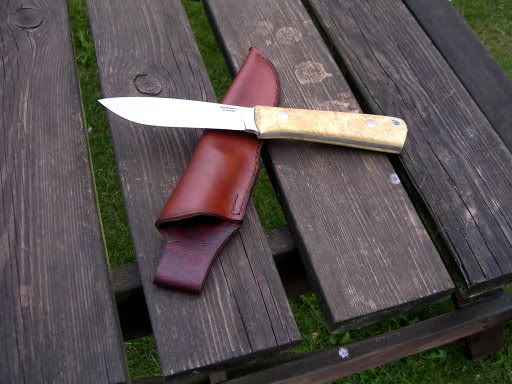

First Impressions
The knife arrived in its sheath, there was a bit of the handle poking out and the wood was rather pretty. The knife pulled out of the sheath without any trouble. Some people have had problems when posting knives in a sheath but there werent any problems with this one. I dont know if Guy goes over his knives with a tuff cloth before posting.
The fit and finish is very good, the handle slabs are flush with the tang and the pins holding them on are nice and smooth. The blade is a rather unusual shape but it seems to work well (more on that later). The overall length is a little larger then the current crop of woodlore clones and the whole different approach of this knife is part of the reason I wanted one in the first place. The blade has a satin finish, which is very nice and evenly done. I think the blade stats out flat and then turn in a convex profile to form the cutting edge. Its blended perfectly though and is the sharpest knife Ive received. I can put a very good edge on knives and normally spend a little time sorting out any little burrs that a knife might have but there was no need in this case. Hairs just jump off my arm with no drag. On the left hand side of the blade there is a small but stylish makers logo, which reads Guy Stainthorpe England. I hate large logos and think that this one is quite tasteful; I also like the fact that it says England on it.
with some other knives
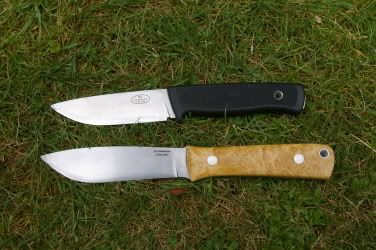
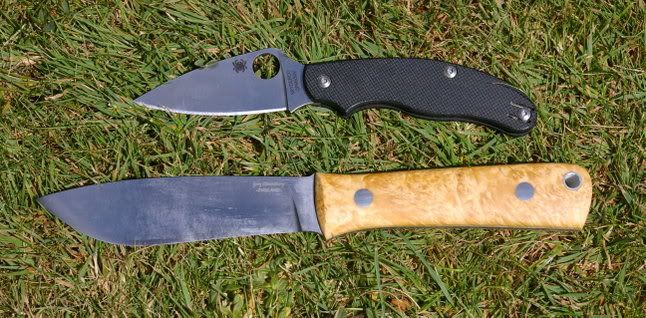
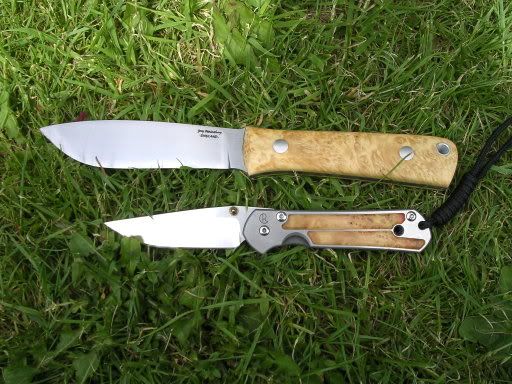
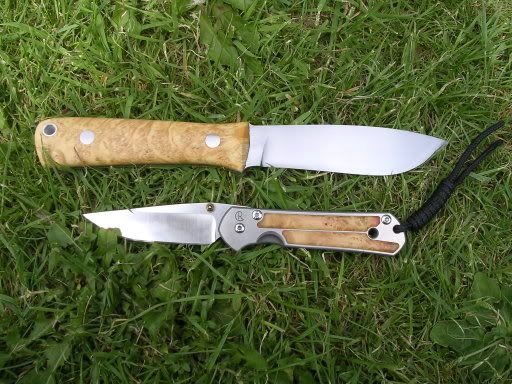
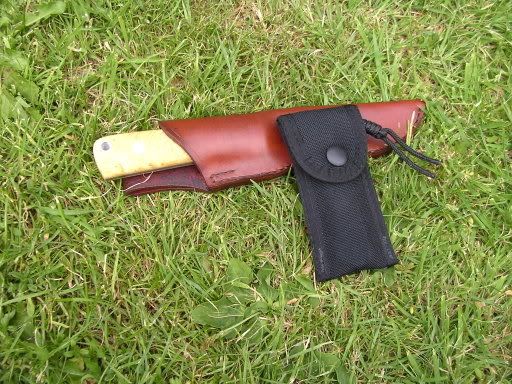
Handle
The handle is 115mm long, about 18mm wide for the most part and around 27mm deep. This makes it a tad longer then most of the handles on other bushcrafters by a few mm and importantly a few mm wider then the F1. This will please a lot of F1 owners with sore hands.
I chose stabilised Box Elder wood. Guy suggested that I have a look on brisa and find something that I liked, he ordered what I asked for we made sure that the block he was getting was the same as Id been meaning as there were a few different colours of the wood. Of course if you want a handle made from something which costs a bit less then the knife will be slightly cheaper. I think that the posh wood gives the knife a bit more of custom feel then a black micarta handle. It has very thin liners, which dont show up very much, but I would assume they allow a good transition between the wood and the tang. Guy normally uses stabilised wood or micarta (I think). Some people may feel that this isnt quite so bushcrafty as a normal wood. They are silly; it looks like wood, feels like wood and lasts. Ive never really though of stainless as any less bushcraft like either
I have no idea what sort of pins or bolts it uses and frankly I dont care, the look good and I cant think why whatever they are would ever fail which is all that matters to me. Its go a lanyard hole and though I dont normally use one I think this might get a short one to give a little extra to grab when getting it out of the sheath (most likely a CRK style one)
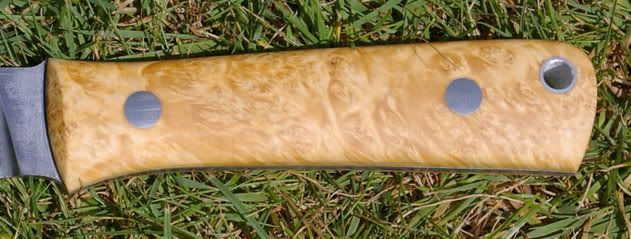

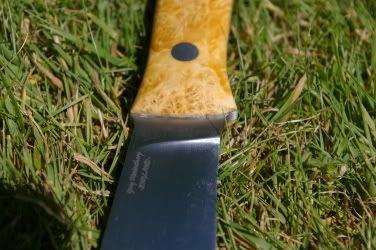
Blade
This is where this knife seems so different from anything else I own. Like the handle its slightly longer then most of my knives. The shape is very unusual and yet not that different in use to others. I didnt notice any difference in using the slight recurve from a straight cutting edge and though the blade rises slightly at the top it drops back down again. It seemed a bit huge as Ive got used to using a very small blade but when I measured it I realised its only 115mm long. Thats only 5mm longer then a woodlore and most people say anything up to 12cm is the best option. Its 4mm thick so is the fairly standard thickness for current crop of knives for outdoor use but being a convex grind it wont have quite as much steel there as a scandi grind knife of the same thickness. Though of a similar spine thickness this is ground a fair bit thinner then the F1 and is IMO a better profile. The head of fallkniven once told me that they leave so much metal on their blades as users with less skill have a stronger edge they are less likely to damage while more experienced users can take metal off if they want, they couldnt put it back on. This is fair enough for a survival knife but I think most people would get on better with the thinner convex this has. One thing people may want to request differently is for a sharper spine, the one on mine is a little rounded for some peoples taste. I dont use my knife with a Ferro rod and dont carry them together so I like it. The ricasso isnt all that big but the cutting edge doesnt start right away which may concern some people.

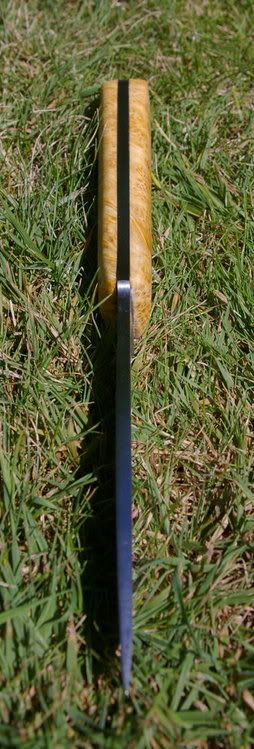

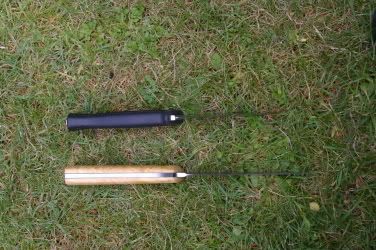



Sheath
At first the sheath looks a little basic compared to some but I like it. I am not a fan of fire steel loops or little pockets for sharpening stones. I assume Guy could put a loop on for fire steel if you want. Once Id finally decided to get a leather sheath I started looking around for sheaths that I like. Firstly I like sloping tops when the sheath is an open deep carry sheath, I think they look nice and help when getting the knife out. I also have a ling about the odd line here and there being the only real decoration to a sheath. It serves no purpose as far as I can see but I like it so I wanted that. I also wanted a sheath where the belt loop curved round at the back and was attacked to the side of the sheath at the bottom rather then the middle. I went and looked for examples of sheaths like this and found an ideal one, in someone elses review of a Guycep bushcrafter.
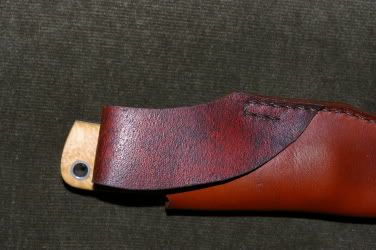
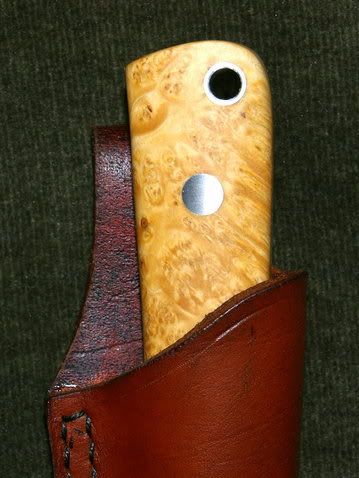
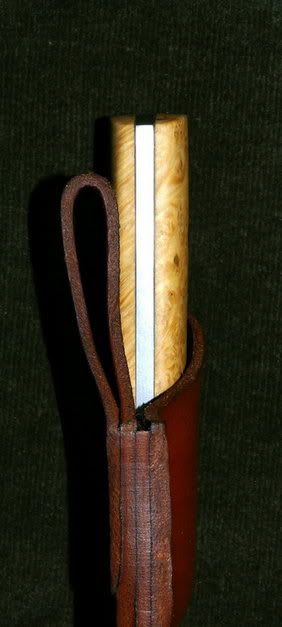
In Use
Ive been playing with it for a couple of days now so its not a huge amount of time to find out if there are any minor things but I think that anything major would have shown up. Firstly the handle is a lot nicer to use then the standard F1, No hot spots from a bit of wood carving, also less effort is required in the first place when cutting things which always helps. The edge seems to have kept its edge and I wonder if it was affected by me having to get out the metal polish to get rid of a hint of rust from a grubby finger mark. Im still very much in the baby it phase of owning this knife and was somewhat upset when I scratched the blade the first time I used it with a baton. It does work well with a baton, Im not really sure what a scandi ground knives of the same are like with them as I dont baton with my scandi so I cant really say if its much better or worse. I would think that the thinner grind this has compared to the F1 would mean that the cutting edge might be doing some of the work rather then the blade acting as a wedge. I cant see this having a huge effect on how much you can baton with it before youll need to sharpen it. The extra blade length doesnt seem to put it at either much of a advantage or disadvantage over the shorter F1, I had to choke up on the blade when drilling with the tip while I can get away with not doing on the shorter F1 but its best to with F1. Both knives have the tip fairly high and this reduces tip control anyway but it doesnt cause problems. This also means that you get more cutting edge for the length of blade, which is helpful when slicing things.
I did try the using the knife with a glove and this was a lot more difficult then with the F1, the very smooth wood was more slippy then the plastic handle of the F1 but its rare that I use a knife like this while wearing gloves (I use a MoD blade in the garden for rough stuff). The quick answer to how this that it does just about everything the F1 does better which was why I bought it. Ive used it for a little food prep but no meat/butcher work. Ive thought about getting my dad to do a bit of work with it but decided that its not important to me and that it will be fine with it. Any knife thats 4mm thick at the spine isnt going to be the best kitchen knife my large 10inch chef knife is only 3mm thick but its also a lot deeper, unlike a 4mm thick scandi knife this can cut thinks rather then making carrots or potatoes without them becoming airborne. Less firm food is a lot easier; its easier going then the f1 as well because its thinner near the edge and also a little sharper. I did go and wipe it clean and the reapply some marine tuff cloth straight away, which I wouldnt do with a stainless knife. I guess you could ask if it could be made in a stainless steel, I dont know how it would affect the cost though
The only thing I used it for that got slightly uncomfortable was when using a reverse grip when wood carving. Because the cutting edge isnt as close to the handle as the F1 more of my hand ended up pressing against the spine rather then the handle.
Conclusion
So is this knife the perfect bushcraft knife? Well it depends what your cutting most or what conditions your using it in. If I lived by the sea or did lots of messy things I wouldnt get a carbon knife, I would see if I could get this in stainless and I have no doubt that the stabilised wood handle would be fine with it. As it is, this knife is cheaper the a micarta F1 and out performs it is both its cutting ability and handle comfort. Added to the fact that this is the coolest looking bushcraft knife around fully hand made in the UK by someone who is easy to deal with and would consider adapting it for your requirements (though the scope for change may be limited by the size of steel the maker has (2mm by 30mm)) it seems a great choice. Judging by how fast one of Guys knives sold for it looks like it should hold its resale value well
nearly forgot
here are a couple of pics of other bushcrafters he's made
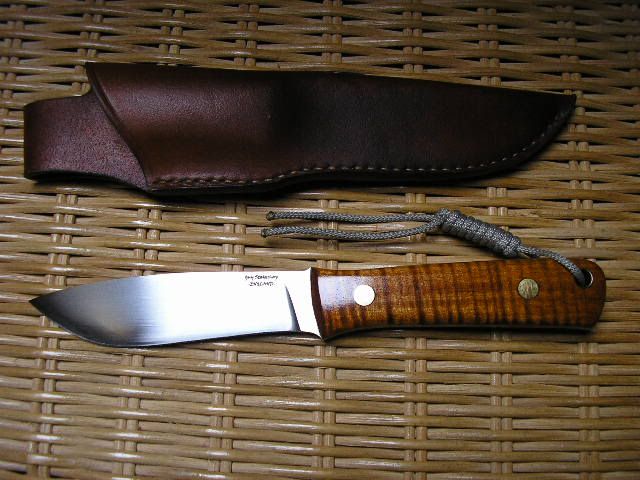
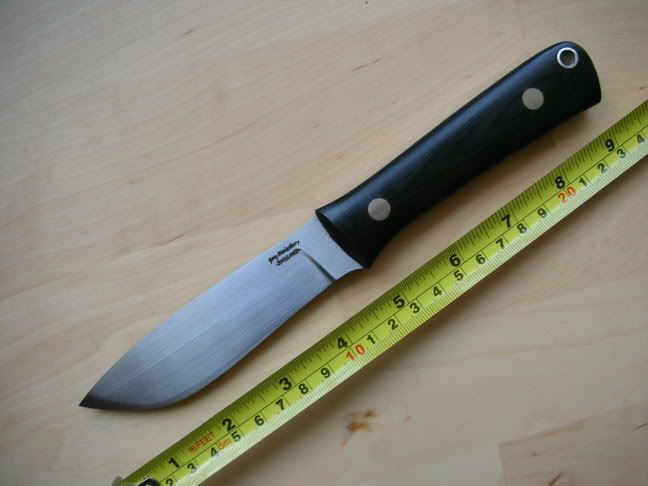
Im not really sure what is now considered a bushcraft knife, calling a knife a bushcraft knife is now a bit like calling any large blade knife a bowie knife, I thought Id call it a bushcrafter as it might help people find the thread. Its also a bit of a story on why I chose to get it and in parts is a comparison review with a fallkniven F1, simply because its a similar sized convex ground knife.
For those that Don't know Guy is a maker on britishblades who does some very nice work
Background
I used to go for dark wood for knife handles, this went on for a long time and then two things happened. Firstly when doing a review of one knife I had my F1 in a cargo pocket to compare it to, dropped the F1 in the woods at night and spent ages looking for it with a rather poor key ring torch (Ive since got a better torch on my keys as well). The second thing that happened was I got a small classic sebenza with stabilized Box Elder inlay, I really liked it and since Id always liked Guys knives when I got the funds to order one with this wood I did.
Another reason for getting this is that I like the F1; I do however think the handle should be a little thicker and the blade ground a little thinner. Some people would suggest getting the version with the micarta handle, this is possibly a better-shaped handle for longer use but the knife has more of a guard, which I dont like, and it costs nearly £160. For that sort of money you can get a custom maker to either handle a blade for you or get a custom knife made from scratch. The latter can be ground thinner to start off with and will be far more unique. It also cost a fair bit less then the micarta F1. I think it looks a lot cooler too.




First Impressions
The knife arrived in its sheath, there was a bit of the handle poking out and the wood was rather pretty. The knife pulled out of the sheath without any trouble. Some people have had problems when posting knives in a sheath but there werent any problems with this one. I dont know if Guy goes over his knives with a tuff cloth before posting.
The fit and finish is very good, the handle slabs are flush with the tang and the pins holding them on are nice and smooth. The blade is a rather unusual shape but it seems to work well (more on that later). The overall length is a little larger then the current crop of woodlore clones and the whole different approach of this knife is part of the reason I wanted one in the first place. The blade has a satin finish, which is very nice and evenly done. I think the blade stats out flat and then turn in a convex profile to form the cutting edge. Its blended perfectly though and is the sharpest knife Ive received. I can put a very good edge on knives and normally spend a little time sorting out any little burrs that a knife might have but there was no need in this case. Hairs just jump off my arm with no drag. On the left hand side of the blade there is a small but stylish makers logo, which reads Guy Stainthorpe England. I hate large logos and think that this one is quite tasteful; I also like the fact that it says England on it.
with some other knives





Handle
The handle is 115mm long, about 18mm wide for the most part and around 27mm deep. This makes it a tad longer then most of the handles on other bushcrafters by a few mm and importantly a few mm wider then the F1. This will please a lot of F1 owners with sore hands.
I chose stabilised Box Elder wood. Guy suggested that I have a look on brisa and find something that I liked, he ordered what I asked for we made sure that the block he was getting was the same as Id been meaning as there were a few different colours of the wood. Of course if you want a handle made from something which costs a bit less then the knife will be slightly cheaper. I think that the posh wood gives the knife a bit more of custom feel then a black micarta handle. It has very thin liners, which dont show up very much, but I would assume they allow a good transition between the wood and the tang. Guy normally uses stabilised wood or micarta (I think). Some people may feel that this isnt quite so bushcrafty as a normal wood. They are silly; it looks like wood, feels like wood and lasts. Ive never really though of stainless as any less bushcraft like either
I have no idea what sort of pins or bolts it uses and frankly I dont care, the look good and I cant think why whatever they are would ever fail which is all that matters to me. Its go a lanyard hole and though I dont normally use one I think this might get a short one to give a little extra to grab when getting it out of the sheath (most likely a CRK style one)



Blade
This is where this knife seems so different from anything else I own. Like the handle its slightly longer then most of my knives. The shape is very unusual and yet not that different in use to others. I didnt notice any difference in using the slight recurve from a straight cutting edge and though the blade rises slightly at the top it drops back down again. It seemed a bit huge as Ive got used to using a very small blade but when I measured it I realised its only 115mm long. Thats only 5mm longer then a woodlore and most people say anything up to 12cm is the best option. Its 4mm thick so is the fairly standard thickness for current crop of knives for outdoor use but being a convex grind it wont have quite as much steel there as a scandi grind knife of the same thickness. Though of a similar spine thickness this is ground a fair bit thinner then the F1 and is IMO a better profile. The head of fallkniven once told me that they leave so much metal on their blades as users with less skill have a stronger edge they are less likely to damage while more experienced users can take metal off if they want, they couldnt put it back on. This is fair enough for a survival knife but I think most people would get on better with the thinner convex this has. One thing people may want to request differently is for a sharper spine, the one on mine is a little rounded for some peoples taste. I dont use my knife with a Ferro rod and dont carry them together so I like it. The ricasso isnt all that big but the cutting edge doesnt start right away which may concern some people.







Sheath
At first the sheath looks a little basic compared to some but I like it. I am not a fan of fire steel loops or little pockets for sharpening stones. I assume Guy could put a loop on for fire steel if you want. Once Id finally decided to get a leather sheath I started looking around for sheaths that I like. Firstly I like sloping tops when the sheath is an open deep carry sheath, I think they look nice and help when getting the knife out. I also have a ling about the odd line here and there being the only real decoration to a sheath. It serves no purpose as far as I can see but I like it so I wanted that. I also wanted a sheath where the belt loop curved round at the back and was attacked to the side of the sheath at the bottom rather then the middle. I went and looked for examples of sheaths like this and found an ideal one, in someone elses review of a Guycep bushcrafter.



In Use
Ive been playing with it for a couple of days now so its not a huge amount of time to find out if there are any minor things but I think that anything major would have shown up. Firstly the handle is a lot nicer to use then the standard F1, No hot spots from a bit of wood carving, also less effort is required in the first place when cutting things which always helps. The edge seems to have kept its edge and I wonder if it was affected by me having to get out the metal polish to get rid of a hint of rust from a grubby finger mark. Im still very much in the baby it phase of owning this knife and was somewhat upset when I scratched the blade the first time I used it with a baton. It does work well with a baton, Im not really sure what a scandi ground knives of the same are like with them as I dont baton with my scandi so I cant really say if its much better or worse. I would think that the thinner grind this has compared to the F1 would mean that the cutting edge might be doing some of the work rather then the blade acting as a wedge. I cant see this having a huge effect on how much you can baton with it before youll need to sharpen it. The extra blade length doesnt seem to put it at either much of a advantage or disadvantage over the shorter F1, I had to choke up on the blade when drilling with the tip while I can get away with not doing on the shorter F1 but its best to with F1. Both knives have the tip fairly high and this reduces tip control anyway but it doesnt cause problems. This also means that you get more cutting edge for the length of blade, which is helpful when slicing things.
I did try the using the knife with a glove and this was a lot more difficult then with the F1, the very smooth wood was more slippy then the plastic handle of the F1 but its rare that I use a knife like this while wearing gloves (I use a MoD blade in the garden for rough stuff). The quick answer to how this that it does just about everything the F1 does better which was why I bought it. Ive used it for a little food prep but no meat/butcher work. Ive thought about getting my dad to do a bit of work with it but decided that its not important to me and that it will be fine with it. Any knife thats 4mm thick at the spine isnt going to be the best kitchen knife my large 10inch chef knife is only 3mm thick but its also a lot deeper, unlike a 4mm thick scandi knife this can cut thinks rather then making carrots or potatoes without them becoming airborne. Less firm food is a lot easier; its easier going then the f1 as well because its thinner near the edge and also a little sharper. I did go and wipe it clean and the reapply some marine tuff cloth straight away, which I wouldnt do with a stainless knife. I guess you could ask if it could be made in a stainless steel, I dont know how it would affect the cost though
The only thing I used it for that got slightly uncomfortable was when using a reverse grip when wood carving. Because the cutting edge isnt as close to the handle as the F1 more of my hand ended up pressing against the spine rather then the handle.
Conclusion
So is this knife the perfect bushcraft knife? Well it depends what your cutting most or what conditions your using it in. If I lived by the sea or did lots of messy things I wouldnt get a carbon knife, I would see if I could get this in stainless and I have no doubt that the stabilised wood handle would be fine with it. As it is, this knife is cheaper the a micarta F1 and out performs it is both its cutting ability and handle comfort. Added to the fact that this is the coolest looking bushcraft knife around fully hand made in the UK by someone who is easy to deal with and would consider adapting it for your requirements (though the scope for change may be limited by the size of steel the maker has (2mm by 30mm)) it seems a great choice. Judging by how fast one of Guys knives sold for it looks like it should hold its resale value well
nearly forgot
here are a couple of pics of other bushcrafters he's made


